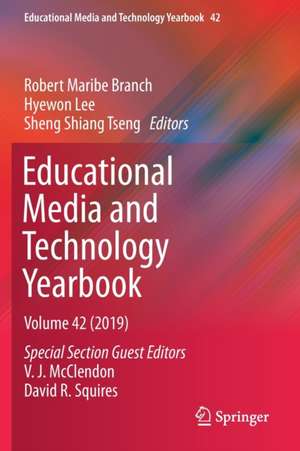Educational Media and Technology Yearbook: Volume 42: Educational Media and Technology Yearbook, cartea 42
Editat de Robert Maribe Branch, Hyewon Lee, Sheng Shiang Tsengen Limba Engleză Paperback – 15 noi 2020
In addition, Volume 42 features the Virtual Reality (VR) and Augmented Reality (AR) research and educational use cases, organized and coordinated by Vivienne and David. This section provides evidence that the affordances of AR, VR, and mixed reality, defined as an immersive multi-platform experience reality (XR), have begunto make indelible changes in teaching and learning in the United States. XR’s recent developments stimulated the editors to propose a special edition to mark the interoperability of immersive technology to push the boundaries of human curiosity, creativity, and problem solving. After years of incremental development, XR has reached a critical level of investment, infrastructure, and emerging production. The chapters included in this section illustrate how XR can push user inquiry, engagement, learning, and interactivity to new levels within physical and digital contexts.
| Toate formatele și edițiile | Preț | Express |
|---|---|---|
| Paperback (1) | 952.72 lei 6-8 săpt. | |
| Springer International Publishing – 15 noi 2020 | 952.72 lei 6-8 săpt. | |
| Hardback (1) | 959.04 lei 6-8 săpt. | |
| Springer International Publishing – 15 noi 2019 | 959.04 lei 6-8 săpt. |
Preț: 952.72 lei
Preț vechi: 1161.85 lei
-18% Nou
Puncte Express: 1429
Preț estimativ în valută:
182.31€ • 194.95$ • 152.00£
182.31€ • 194.95$ • 152.00£
Carte tipărită la comandă
Livrare economică 18 aprilie-02 mai
Preluare comenzi: 021 569.72.76
Specificații
ISBN-13: 9783030279882
ISBN-10: 303027988X
Pagini: 456
Ilustrații: XIV, 456 p. 43 illus., 39 illus. in color.
Dimensiuni: 155 x 235 mm
Greutate: 0.65 kg
Ediția:1st ed. 2019
Editura: Springer International Publishing
Colecția Springer
Seria Educational Media and Technology Yearbook
Locul publicării:Cham, Switzerland
ISBN-10: 303027988X
Pagini: 456
Ilustrații: XIV, 456 p. 43 illus., 39 illus. in color.
Dimensiuni: 155 x 235 mm
Greutate: 0.65 kg
Ediția:1st ed. 2019
Editura: Springer International Publishing
Colecția Springer
Seria Educational Media and Technology Yearbook
Locul publicării:Cham, Switzerland
Cuprins
Part I Trends and Issues in Learning, Design, and Technology Issues and Trends in Instructional Technology: Access to Mobile Technologies, Digital Content, and Online Learning Opportunities Continues as Spending on IT Remains Steady.- Second Thoughts: Understanding the Impact and Appropriate Use and Non-use of Technologies.- Enhancing Student Critical Literacy through Social Annotations.- The 2019 Scholarship Rankings.- Part II Virtual Reality (VR) and Augmented Reality (AR).- Introduction-US Govt.- The Immersive Experience - How Virtual Reality Can Support Student Learning.- The Effects of a VR Intervention on Career Interest, Empathy, Communication Skills and Learning with 2nd Year Medical Students.- Sensory Worlds: Emotional Geography and Human Centered Design in 360° VR Ethnographic Videos.- Accessing the Pokélayer: Augmented Reality and Fantastical Play in Pokémon Go.- Visualization of Molecular Structures Using Augmented Reality.- Instructional Designs and Educational Technologies within Augmented Reality.- Transmedia Storytelling: IDET ARTS VR as Library Technology: Early Faculty and Student Feedback on Educational Use of Immersive Technology.- Review Paper: Immersive Media and Their Future.- Part III Leadership Profiles Introduction.- Ana Donaldson.- Richard Cornell.- Part IV Organizations and Associations in North America Introduction.- Organizations and Associations in the US and Canada.- Part V Graduate Programs Introduction.- Graduate Programs in Learning, Design, Technology, Information, or Libraries.- Part VI Mediagraphy Introduction.- Mediagraphy.
Notă biografică
Robert Maribe Branch is a professor of Learning, Design, and Technology at the University of Georgia in Athens, GA.
Textul de pe ultima copertă
This is Volume 42 of the Educational Media and Technology Yearbook. For the past 40 years, our Yearbook has contributed to the field of Educational Technology in presenting contemporary topics, ideas, and developments regarding diverse technology tools for educational purposes. Our Yearbook has inspired researchers, practitioners, and teachers to consider how to develop technological designs and develop curricula and instruction integrating technology to enhance student learning, teach diverse populations across levels with effective technology integration, and apply technology in interactive ways to motivate students to engage in course content.
In addition, Volume 42 features the Virtual Reality (VR) and Augmented Reality (AR) research and educational use cases, organized and coordinated by Vivienne and David. This section provides evidence that the affordances of AR, VR, and mixed reality, defined as an immersive multi-platform experience reality (XR), have begunto make indelible changes in teaching and learning in the United States. XR’s recent developments stimulated the editors to propose a special edition to mark the interoperability of immersive technology to push the boundaries of human curiosity, creativity, and problem solving. After years of incremental development, XR has reached a critical level of investment, infrastructure, and emerging production. The chapters included in this section illustrate how XR can push user inquiry, engagement, learning, and interactivity to new levels within physical and digital contexts.
In addition, Volume 42 features the Virtual Reality (VR) and Augmented Reality (AR) research and educational use cases, organized and coordinated by Vivienne and David. This section provides evidence that the affordances of AR, VR, and mixed reality, defined as an immersive multi-platform experience reality (XR), have begunto make indelible changes in teaching and learning in the United States. XR’s recent developments stimulated the editors to propose a special edition to mark the interoperability of immersive technology to push the boundaries of human curiosity, creativity, and problem solving. After years of incremental development, XR has reached a critical level of investment, infrastructure, and emerging production. The chapters included in this section illustrate how XR can push user inquiry, engagement, learning, and interactivity to new levels within physical and digital contexts.
Caracteristici
Provides continually updated information on media and technology education programs Published in partnership with the AECT Identifies leading educational technology programs and scholars in the field






